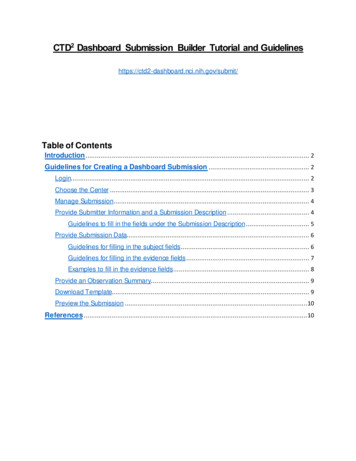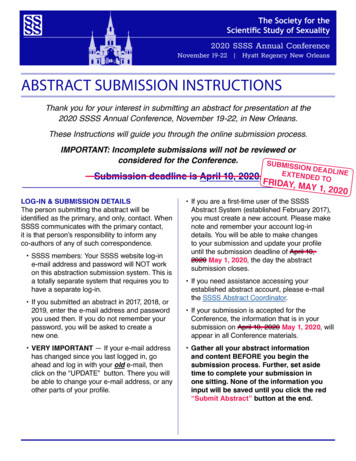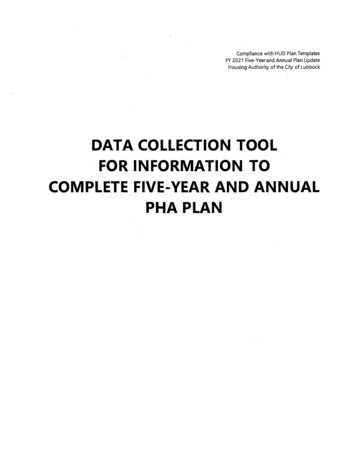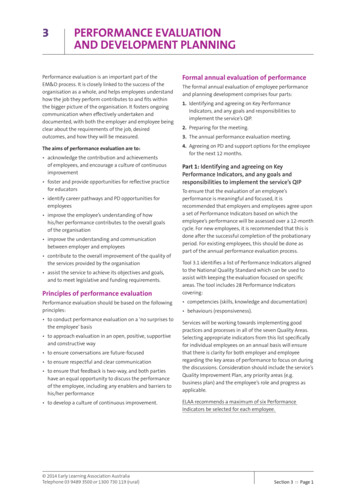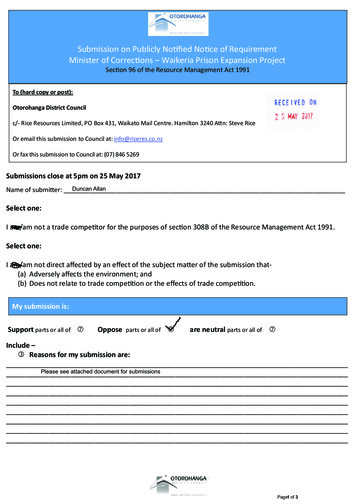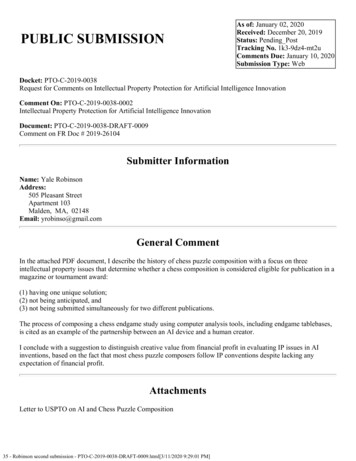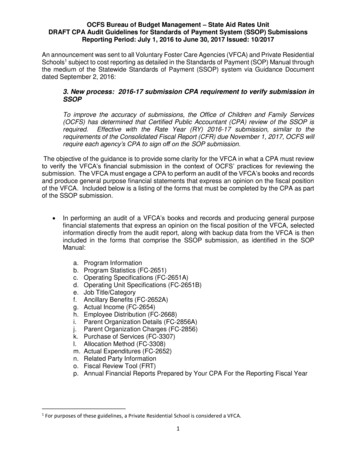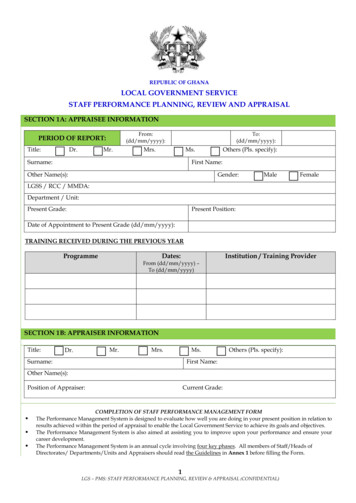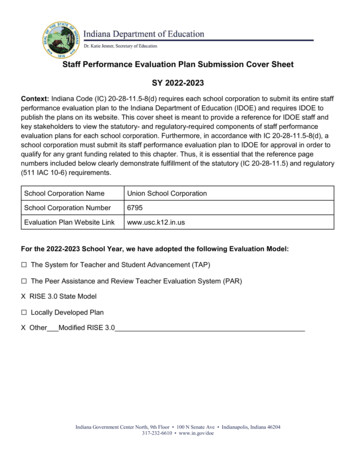
Transcription
Staff Performance Evaluation Plan Submission Cover SheetSY 2022-2023Context: Indiana Code (IC) 20-28-11.5-8(d) requires each school corporation to submit its entire staffperformance evaluation plan to the Indiana Department of Education (IDOE) and requires IDOE topublish the plans on its website. This cover sheet is meant to provide a reference for IDOE staff andkey stakeholders to view the statutory- and regulatory-required components of staff performanceevaluation plans for each school corporation. Furthermore, in accordance with IC 20-28-11.5-8(d), aschool corporation must submit its staff performance evaluation plan to IDOE for approval in order toqualify for any grant funding related to this chapter. Thus, it is essential that the reference pagenumbers included below clearly demonstrate fulfillment of the statutory (IC 20-28-11.5) and regulatory(511 IAC 10-6) requirements.School Corporation NameUnion School CorporationSchool Corporation Number6795Evaluation Plan Website Linkwww.usc.k12.in.usFor the 2022-2023 School Year, we have adopted the following Evaluation Model: The System for Teacher and Student Advancement (TAP) The Peer Assistance and Review Teacher Evaluation System (PAR)X RISE 3.0 State Model Locally Developed PlanX Other Modified RISE 3.0Indiana Government Center North, 9th Floor 100 N Senate Ave Indianapolis, Indiana 46204317-232-6610 www.in.gov/doe
RISEEvaluation ModelEvaluator and Teacher Handbook Version 3.0
ContentsIndiana’s State Model on Teacher Evaluation . 4Background/Context . 4Timeline for Development . 5Performance Level Ratings . 5A System for Teachers . 6Overview of Components . 6Component 1: Professional Practice . 7Indiana Teacher Effectiveness Rubric: Background and Context . 7Indiana Teacher Effectiveness Rubric: Overview . 8The Indiana Teacher Effectiveness Rubric . 8Observation of Teacher Practice: Questions and Answers for Teachers . 9Teacher Effectiveness Rubric: Scoring . 11The Role of Professional Judgment. 16Component 2: Additional Components . 17Additional Components Overview . 17Summative Teacher Evaluation Scoring. 18Options for Weighting of Measures. 18Glossary of RISE Terms. 20Appendix A – Allowable Modifications to RISE . 22Appendix B – Optional Observation and Conferencing Forms . 23Optional Observation Mapping Form 1 – By Competency . 24Optional Pre-Observation Form - Teacher. 28Optional Post-Observation Form - Evaluators . 29Optional Post-Observation Form – Teacher . 30Optional Mid-Year Professional Practice Check-In Form . 31Optional Summative Rating Form . 36Teacher Effectiveness Rubric Scoring . 36Final Summative Rating (Option 1) . 40Final Summative Rating (Option 2) .422 Page
Optional Professional Development Plan. 41Appendix C – Indiana Teacher Effectiveness Rubric . 463 Page
Indiana’s State Model on Teacher EvaluationBackground/ContextRISE was designed and revised to provide a quality system, aligned with current legislativerequirements that local corporations can adopt in its entirety, or use as a model as they developevaluation systems to best suit their local contexts. RISE was developed over the course of ayear by the Indiana Teacher Evaluation Cabinet, a diverse group of educators and administratorsfrom around the state, more than half of whom have won awards for excellence in teaching. Theseindividuals dedicated their time to develop a system that represents excellence in instruction andserves to guide teacher development. To make sure that their efforts represented the best thinkingfrom around the state, their work was circulated widely to solicit feedback from educatorsthroughout Indiana.A meaningful teacher evaluation system should reflect a set of core convictions about goodinstruction. From the beginning, the Indiana Teacher Evaluation Cabinet sought to design a modelevaluation system focused on good instruction and student outcomes. RISE was designed to befair, accurate, transparent, and easy-to-use. IDOE staff and the Indiana Teacher EvaluationCabinet relied on three core beliefs about teacher evaluation during the design of RISE: Nothing we can do for our students matters more than giving them effectiveteachers. Research has proven this time and again. We need to do everything we can togive all our teachers the support they need to do their best work, because when theysucceed, our students succeed. Without effective evaluation systems, we can’t identifyand retain excellent teachers, provide useful feedback and support, or intervene whenteachers consistently perform poorly. Teachers deserve to be treated like professionals. Unfortunately, many evaluationstreat teachers like interchangeable parts—rating nearly all teachers the same and failingto give teachers the accurate, useful feedback they need to do their best work in theclassroom. We need to create an evaluation system that gives teachers regular feedbackon their performance, opportunities for professional growth, and recognition when they doexceptional work. We are committed to creating evaluations that are fair, accurate andconsistent, based on multiple factors that paint a complete picture of each teacher’ssuccess in helping students learn. A new evaluation system will make a positive difference in teachers’ everyday lives.Novice and veteran teachers alike can look forward to detailed, constructive feedback,tailored to the individual needs of their classrooms and students. Teachers and principalswill meet regularly to discuss successes and areas for improvement, set professionalgoals, and create an individualized development plan to meet those goals.4 Page
Timeline for DevelopmentThe timeline below reflects the roll-out of the state model for teacher evaluation. Legislaturerequired statewide implementation of new or modified evaluation systems compliant with IC 2028-11.5-4 by school year 2012-2013. To assist corporations in creating evaluation models of theirown, the state piloted RISE in school year 2011-2012. All documents for RISE version 1.0 werereleased by January 2012, and key lessons from the pilot led to RISE 2.0, the refined model ofthe original system. House Enrolled Act (HEA) 1002 (2020) amended existing I.C. 20-28-11.5-4by removing the requirement that student assessment results from statewide standardizedassessments be used as part of a certified employee’s annual evaluation performance plan. Thislegislative change led to the further refinement of the original system to create RISE 3.0.Corporations may choose to adopt RISE entirely, draw on components from the model, or createtheir own system for implementation. Though corporations are encouraged to choose or adaptthe evaluation system that best meet the needs of their local schools and teachers, in order tomaintain consistency, only corporations that adopt the RISE system wholesale or make only minorchanges may use the RISE label, and are thus considered by IDOE to be using a version of RISE.For a list of allowable modifications of the RISE system, see Appendix A.Figure 1: Timeline for RISE design and implementationRISEDesign‘10-‘11Pilot andRefine RISE’11-‘12ReleaseRISE version1.0 Jan ‘12ReleaseRISE version2.0 Aug E version3.0 July ‘20* Note: Statewide implementation refers to corporations adopting new evaluations systems in linewith Indiana Code requirements. RISE is an option and resource for corporations, but is notmandatory.Performance Level RatingsEach teacher will receive a rating at the end of each school year in one of four performance levels: Highly Effective: A highly effective teacher consistently exceeds expectations. This is ateacher who has demonstrated excellence, as determined by a trained evaluator, in locallyselected competencies reasonably believed to be highly correlated with positive studentlearning outcomes. Effective: An effective teacher consistently meets expectations. This is a teacher who hasconsistently met expectations, as determined by a trained evaluator, in locally selectedcompetencies reasonably believed to be highly correlated with positive student learningoutcomes.Improvement Necessary: A teacher who is rated as improvement necessary requires achange in performance before he/she meets expectations. This is a teacher who a trained 5 Page
evaluator has determined to require improvement in locally selected competenciesreasonably believed to be highly correlated with positive student learning outcomes. Ineffective: An ineffective teacher consistently fails to meet expectations. This is ateacher who has failed to meet expectations, as determined by a trained evaluator, inlocally selected competencies reasonably believed to be highly correlated with positivestudent learning outcomes.A System for TeachersRISE was created with classroom teachers in mind and may not be always be appropriate to useto evaluate school personnel who do not directly teach students, such as instructional coaches,counselors, etc. Though certain components of RISE can be easily applied to individuals insupport positions, it is ultimately a corporation’s decision whether or not to modify RISE or adapta different evaluation system for these roles. Corporations that modify RISE or adapt a differentsystem for non-classroom teachers are still considered by the Indiana Department of Educationto be using a version of RISE as long as they are using RISE for classroom teachers and thisversion of RISE meets the minimum requirements specified in Appendix A.Overview of ComponentsEvery teacher is unique, and the classroom is a complex place. RISE relies on multiple sourcesof information to paint a fair, accurate, and comprehensive picture of a teacher’s performance.While professional practice will be evaluated on the Indiana Teacher Effectiveness Rubric,corporations may also choose to incorporate additional components that fit local goals andcontext.1. Professional Practice – Assessment of instructional knowledge and skills that influencestudent learning, as measured by competencies set forth in the Indiana TeacherEffectiveness Rubric. All teachers will be evaluated in the domains of Planning, Instruction,Leadership, and Core Professionalism.2. Additional Components – Current legislation allows for the following components to beused to inform teacher evaluations: Test scores of students (both formative andsummative); Classroom presentation observations; Observation of student-teacherinteraction; Knowledge of subject matter; Dedication and effectiveness of the teacherthrough time and effort on task; Contributions of teachers through group teacherinteractivity in fulfilling the school improvement plan; Cooperation of the teacher withsupervisors and peers; Extracurricular contributions of the teacher; Outside performanceevaluations; Compliance with school corporation rules and procedures; or Other itemsconsidered important by the school corporation in developing each student to the student'smaximum intellectual potential and performance.6 Page
Component 1: Professional PracticeIndiana Teacher Effectiveness Rubric: Background and ContextThe Teacher Effectiveness Rubric was developed for three key purposes:1. To shine a spotlight on great teaching: The rubric is designed to assist principals intheir efforts to increase teacher effectiveness, recognize teaching quality, and ensure thatall students have access to great teachers.2. To provide clear expectations for teachers: The rubric defines and prioritizes theactions that effective teachers use to make gains in student achievement.3. To support a fair and transparent evaluation of effectiveness: The rubric provides thefoundation for accurately assessing teacher effectiveness along four discrete ratings.While drafting the Teacher Effectiveness Rubric, the development team examined teachingframeworks from numerous sources, including: Charlotte Danielson’s Framework for TeachersIowa’s A Model FrameworkKIPP Academy’s Teacher Evaluation RubricRobert Marzano’s Classroom Instruction that WorksMassachusetts’ Principles for Effective TeachingKim Marshall’s Teacher Evaluation RubricsNational Board’s Professional Teaching StandardsNorth Carolina’s Teacher Evaluation ProcessDoug Reeves’ Unwrapping the StandardsResearch for Bettering Teaching’s Skillful TeacherTeach For America’s Teaching as Leadership RubricTexas’ TxBess FrameworkWashington DC’s IMPACT Performance AssessmentWiggins & McTighe’s Understanding by DesignIn reviewing the current research during the development of the teacher effectiveness rubric, thegoal was not to create a teacher evaluation tool that would try to be all things to all people. Rather,the rubric focuses on evaluating teachers’ primary responsibility: engaging students in rigorousacademic content so that students learn and achieve. As such, the rubric focuses on evaluatingthe effectiveness of instruction, specifically through observable actions in the classroom.7 Page
Indiana Teacher Effectiveness Rubric: OverviewThe primary portion of the Teacher Effectiveness Rubric consists of three domains and nineteencompetencies.Figure 2: Domains 1-3 and CompetenciesDomain 1: Planning1.11.21.31.41.5Utilize Assessment Data to PlanSet Ambitious and Measurable Achievement GoalsDevelop Standards-Based Unit Plans and AssessmentsCreate Objective-Driven Lesson Plans and AssessmentsTrack Student Data and Analyze ProgressDomain 2: Instruction2.12.22.32.42.52.62.72.82.9Develop Student Understanding and Mastery of Lesson ObjectivesDemonstrate and Clearly Communicate Content Knowledge to StudentsEngage Students in Academic ContentCheck for UnderstandingModify Instruction as NeededDevelop Higher Level of Understanding Through Rigorous Instruction and WorkMaximize Instructional TimeCreate Classroom Culture of Respect and CollaborationSet High Expectations for Academic SuccessDomain 3: Leadership3.13.23.33.43.5Contribute to School CultureCollaborate with PeersSeek Professional Skills and KnowledgeAdvocate for Student SuccessEngage Families in Student LearningIn addition to these three primary domains, the Teacher Effectiveness Rubric contains a fourthdomain, referred to as Core Professionalism, which reflects the non-negotiable aspects of ateacher’s job.The Core Professionalism domain has four criteria: Attendance On-Time Arrival Policies and Procedures RespectThe Indiana Teacher Effectiveness RubricIn Appendix C of this handbook, you will find the Teacher Effectiveness Rubric. All supporting observationand conference documents and forms can be found in Appendix B.8 Page
Observation of Teacher Practice: Questions and Answers for TeachersHow will my proficiency on the Indiana Teacher Effectiveness Rubric be assessed?Your proficiency will be assessed by a primary evaluator, taking into account information collectedthroughout the year during extended observations, short observations, and conferencesperformed by both your primary evaluator as well as secondary evaluators.What is the role of the primary evaluator?Your primary evaluator is responsible for tracking your evaluation results and helping you to setgoals for your development. The primary evaluator must perform at least one of your short and atleast one of your extended observations during the year. Once all data is gathered, the primaryevaluator will look at information collected by all evaluators throughout the year and determineyour summative rating. He or she will meet with you to discuss this final rating in a summativeconference.What is a secondary evaluator?A secondary evaluator may perform extended or short observations as well as work with teachersto set Student Learning Objectives. The data this person collects is passed on to the primaryevaluator responsible for assigning a summative rating.Do all teachers need to have both a primary and secondary evaluator?No. It is possible, based on the capacity of a school or corporation, that a teacher would only havea primary evaluator. However, it is recommended that, if possible, more than one evaluatorcontribute to a teacher’s evaluation. This provides multiple perspectives on a teacher’sperformance and is beneficial to both the evaluator and teacher.What is an extended observation?An extended observation lasts a minimum of 40 minutes. It may be announced or unannounced.It may take place over one class or span two consecutive class periods.Are there mandatory conferences that accompany an extended observation?a. Pre-Conferences: Pre-Conferences are not mandatory, but are scheduled by request ofteacher or evaluator. Any mandatory pieces of information that the evaluator would like tosee during the observation (lesson plans, gradebook, etc.), must be requested of theteacher prior to the extended observation.b. Post-Conferences: Post-Conferences are mandatory and must occur within five schooldays of the extended observation. During this time, the teacher must be presented withwritten and oral feedback from the evaluator.How many extended observations will I have in a year?9 Page
All teachers must have a minimum of two extended observations per year – at least one persemester.Who is qualified to perform extended observations?Any trained primary or secondary evaluator may perform an extended observation. The primaryevaluator assigning the final, summative rating must perform a minimum of one of the extendedobservations.What is a short observation?A short observation lasts a minimum of 10 minutes and should not be announced. There are noconferencing requirements around short observations, but a post-observation conference shouldbe scheduled if there are areas of concern. A teacher must receive written feedback following ashort observation within two school days.How many short observations will I have in a year?All teachers will have a minimum of three short observations – at least one per semester.However, many evaluators may choose to visit classrooms much more frequently than theminimum requirement specified here.Who is qualified to perform short observations?Any primary evaluator or secondary evaluator may perform a short observation. The primaryevaluator assigning the final, summative rating must perform a minimum of one of the shortobservations.Is there any additional support for struggling teachers?It is expected that a struggling teacher will receive observations above and beyond the minimumnumber required by RISE. This may be any combination of extended or short observations andconferences that the primary evaluator deems appropriate. It is recommended that primaryevaluators place struggling teachers on a professional development plan.Will my formal and informal observations be scored?Both extended and short observations are times for evaluators to collect information. There willbe no summative rating assigned until all information is collected and analyzed at the end of theyear. However, all evaluators are expected to provide specific and meaningful feedback onperformance following all observations. For more information about scoring using the TeacherEffectiveness Rubric, please see the scoring section of this handbook.Domain 1: Planning and Domain 3: Leadership are difficult to assess through classroomobservations. How will I be assessed in these Domains?Evaluators should collect material outside of the classroom to assess these domains. Teachersshould also be proactive in demonstrating their proficiency in these areas. However, evidence10 P a g e
collection in these two domains should not be a burden on teachers that detracts from qualityinstruction. Examples of evidence for these domains may include (but are not limited to):a. Domain 1: Planning - lesson and unit plans, planned instructional materials and activities,assessments, and systems for record keepingb. Domain 3: Leadership - documents from team planning and collaboration, call-logs ornotes from parent-teacher meetings, and attendance records from professionaldevelopment or school-based activities/eventsWhat is a professional development plan?An important part of developing professionally is the ability to self-reflect on performance. Theprofessional development plan is a tool for teachers to assess their own performance and setdevelopment goals. In this sense, a professional development plan supports teachers who striveto improve performance, and can be particularly helpful for new teachers. Although every teacheris encouraged to set goals around his/her performance, only teachers who score an “Ineffective”or “Improvement Necessary” on their summative evaluation the previous year are required tohave a professional development plan monitored by an evaluator. This may also serve as theremediation plan specified in Public Law 90.If I have a professional development plan, what is the process for setting goals and assessing myprogress?Teachers needing a professional development plan work with an administrator to set goals at thebeginning of the academic year. These goals are monitored and revised as necessary. Progresstowards goals is formally discussed during the mid-year conference, at which point the evaluatorand teacher discuss the teacher’s performance thus far and adjust individual goals as necessary.Professional development goals should be directly tied to areas of improvement within theTeacher Effectiveness Rubric. Teachers with professional development plans are required to uselicense renewal credits for professional development activities.Is there extra support in this system for new teachers?Teachers in their first few years are encouraged to complete a professional development planwith the support of their primary evaluator. These teachers will benefit from early and frequentfeedback on their performance. Evaluators should adjust timing of observations and conferencesto ensure these teachers receive the support they need. This helps to support growth and also toset clear expectations on the instructional culture of the building and school leadership.Teacher Effectiveness Rubric: ScoringEvaluators are not required to score teachers after any given observation. However, it is essentialthat during the observation the evaluator take evidence-based notes, writing specific instances ofwhat the teacher and students said and did in the classroom. The evidence that evaluators recordduring the observation should be non-judgmental, but instead reflect a clear and concise accountof what occurred in the classroom. The difference between evidence and judgment is highlightedin the examples below.11 P a g e
Figure 3: Evidence vs. JudgmentEvidence(9:32 am) Teacher asks: Does everyone understand?(3 Students nod yes, no response from others)Teacher says: Great, let’s move onJudgmentThe teacher doesn’t do a good job of making surestudents understand concepts.(9:41 am) Teacher asks: How do we determine anelement?(No student responds after 2 seconds)Teacher says: By protons, right?Teacher to Student 1: “Tori, will you explain your work onthis problem?” (Student explains work.)Teacher to Student 2: “Nick, do you agree or disagree withTori’s method?” (Student agrees) “Why do you agree?”The teacher asks students a lot of engagingquestions and stimulates good classroomdiscussion.After the observation, the evaluator should take these notes and match them to the appropriateindicators on the rubric in order to provide the teacher with rubric-aligned feedback during thepost-conference. Although evaluators are not required to provide teachers interim ratings onspecific competencies after observations, the process of mapping specific evidence to indicatorsprovides teachers a good idea of their performance on competencies prior to the end-of-yearconference. Below is an example of a portion of the evidence an evaluator documented, and howhe/she mapped it to the appropriate indicators.Figure 4: Mapping Evidence to IndicatorsEvidence(9:32 am) Teacher asks: Does everyone understand?(3 Students nod yes, no response from others)Teacher says: Great, let’s move on(9:41 am) Teacher asks: How do we determine anelement? (No student responds after 2 seconds)Teacher says: By protons, right?Teacher to Student 1: “Tori, will you explain your work onthis problem?” (Student explains work.)Teacher to Student 2: “Nick, do you agree or disagree withTori’s method?” (Student agrees.) “Why do you agree?”IndicatorCompetency 2.4: Check for UnderstandingTeacher frequently moves on with content beforestudents have a chance to respond to questionsor frequently gives students the answer ratherthan helping them think through the answer.(Ineffective)Competency 2.6: Develop Higher Level ofUnderstanding through Rigorous Instruction andWorkTeacherfrequently developshigher-levelunderstanding through effective questioning.(Effective)12 P a g e
At the end of the year, primary evaluators must determine a final, teacher effectiveness rubricrating and discuss this rating with teachers during the end-of-year conference. The final teachereffectiveness rating will be calculated by the evaluator in a four step process:1Compile ratings and notes from observations, conferences, and other sources ofinformation2Useprofessionaljudgmentto establishthree final ratingsin Planning,Instruction,andCompileratings andnotes frommultiple observations,drop-ins,and other sourcesof evidenceLeadership3Compileratings andnotes tofrommultipleobservations,drop-ins,of evidenceUseestablishedweightsroll-upthreedomain ratingsinto andone otherratingsourcesfor Domains1-3Compile ratings and notes from multiple observations, drop-ins, and other sources of evidenceCompile ratings and notes from multiple observations, drop-ins, and other sources of evidenceCompileratingsandProfessionalismnotes from multipleobservations, drop-ins, and other sources of evidenceIncorporateCorerating4Compile ratings and notes from multiple observations, drop-ins, and other sources of evidenceCompile ratings and notes from multiple observations, drop-ins, and other sources of evidenceEach step is described in detail below.Compile ratings and notes from multiple observations, drop-ins, and other sources of evidence1Compile ratings and notes from observations, conferences, and other sources ofinformation.At the end of the school year, primary evaluators should have collected a body of informationrepresenting teacher practice from throughout the year. Not all of this information will necessarilycome from the same evaluator, but it is the responsibility of the assigned primary evaluator togather information from every person that observed the teacher during that year. In addition tonotes from observations and conferences, evaluators may also have access to materials providedby the teacher, such as lesson plans, student work, parent/teacher conference notes, etc. To aidin the collection of this information, schools should consider having files for teachers containingevaluation information such as observation notes and conference forms, and when possible,maintain this information electronically.Because of the volume of information that may exist for each teacher, some evaluators
treat teachers like interchangeable parts—rating nearly all teachers the same and failing to give teachers the accurate, useful feedback they need to do their best work in the classroom. We need to create an evaluation system that gives teachers regular feedback on their performance, opportunities for professional growth, and recognition when .
